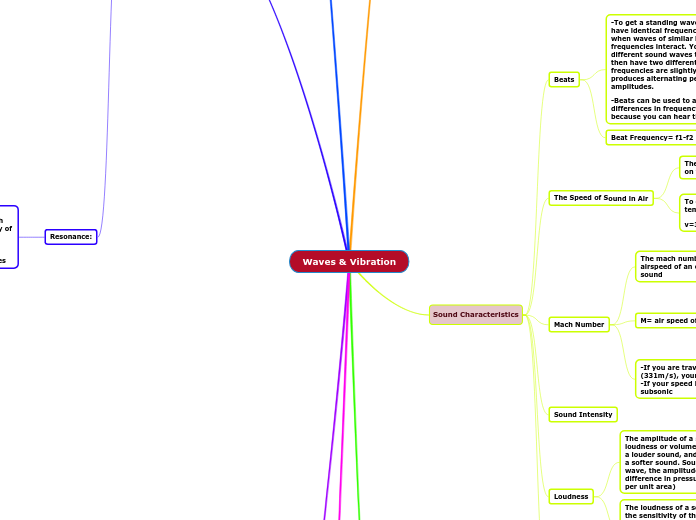Waves & Vibration
Characteristics of
Waves
What are Waves?
Waves are disturbances that
transfer energy from one place to
another
Amplitude:
-The maximum displacement of the
particles from the equilibrium position.
It’s distance between the resting position
and the maximum displacement of the wave.
Crest:
-The highest point on a transverse wave
(also called the peak)
Trough:
-The lowest point on a transverse wave
Period:
-The time for a vibrating particle to complete
one cycle
Frequency:
-The number of complete cycles that
appear in unit time, measured in hertz (Hz)
Equation:
f=1/T
Wavelength:
-The distance between two similar points
in successive identical cycles in a wave. The
length between successive crests/troughs are
equal (measured in meters)
Cycle:
-One complete oscillationundefined

Universal Wave Equation:
-The rate at which a wave is travelling
through a medium; also a measure of how
fast the energy in the wave is moving

Another way to calculate
wave speed (if you have
the period)
V=lambda/T
Sound Characteristics
Beats
-To get a standing wave, the two waves must
have identical frequencies. Beats are produced when waves of similar but not identical frequencies interact. You would like two different sound waves to produce audible beats then have two different frequencies. Since the frequencies are slightly off, the interference produces alternating periods of high and low amplitudes.
-Beats can be used to assess very small differences in frequency between two waves, because you can hear the change in loudness
Beat Frequency= f1-f2
The Speed of Sound in Air
The speed of sound in air depends
on the temperature of the air
To calculate the speed of sound in different
temperatures use:
v=331.4+(0.606)T
Mach Number
The mach number is the ratio of the
airspeed of an object to the local speed of sound
M= air speed of object/ local speed of sound
-If you are traveling faster than Mach 1 (331m/s), your speed is supersonic
-If your speed is below Mach 1, your speed is subsonic
Sound Intensity
Loudness
The amplitude of a sound wave determines its
loudness or volume. A larger amplitude means
a louder sound, and a smaller amplitude means
a softer sound. Sound energy is a longitudinal
wave, the amplitude of a longitudinal wave is a
difference in pressure (pressure is the force per unit area)
P= F/A
Where P is the pressure, F is the force, and
A is the areaundefined
The loudness of a sound is also determined by the sensitivity of the ear. The human ear is more sensitive to some frequencies than to others. The volume we receive thus depends on both the amplitude of a sound wave and whether its frequency lies in a region where the ear is more or less sensitiveundefined
Pitch
The sensation of a frequency is commonly referred to as the pitch of a sound. A high pitch sound corresponds to a high frequency sound wave and a low pitch sound corresponds to a low frequency sound wave
Principle of
Superposition
- When two waves meet, they will always
“interfere” with each other. The individual waves will add together (superposition) so that
a new wavefront is created.
- In general, the concept of amplitude addition is called “The Principle of Superposition"
As each pulse moves in a constant speed of 2 squares per second, on a string which is 16 squares long. The resultant displacement (green) is equal to the sum of the displacements of the individual waves at the point
The two types of interferences that prove this concept
are constructive and destructive interference.
Constructive Interference:
-When two identical waves arrive at the
same point exactly in phase such that
the crests of the two waves are precisely
aligned, as are the troughs. This superposition
produces constructive interference. It produces a wave that has twice the amplitude of the individual waves, but has the same wavelength.undefined
Two crests/troughs meet and
form a super-crest/super-trough

Destructive Interference:
-When two identical waves arrive exactly out of
phase such that they precisely align crest to trough, producing destructive interference. The
resulting amplitude is zero for destructive interference as the waves completely cancel out
each otherundefined
A crest and a trough meet and
cancel each other out


Types of Mechanical
Waves
What are Mechanical Waves?
-Mechanical waves produce when
particles vibrate in a medium in which
the wave propagates. Therefore,
transferring energy through a medium.
-A mechanical wave can be transverse or
longitudinal
Longitudinal Waves:
-A wave in which particles
of the medium move in a
direction parallel to the
direction which the wave
moves
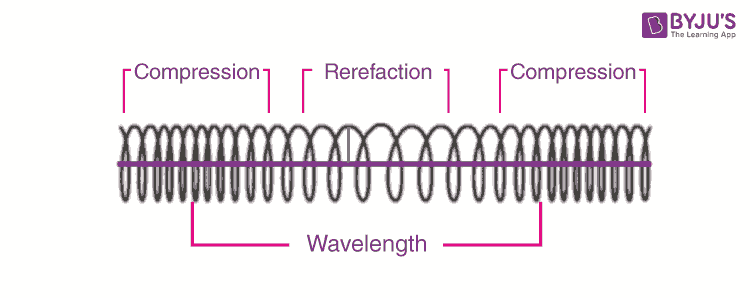
Compression:
The region in a longitudinal wave
in which the medium’s particles
are closer togetherundefined
Rarefraction:
The region in a longitudinal
wave in which the medium’s
particles are farther apartundefined
Transverse Waves:
-A wave in which particles
of the medium move in a
direction perpendicular
to the direction which the
wave movesundefined

Standing Waves
What are Standing Waves:
-A standing wave is the combination
of two waves, moving in opposite
direction; each having the same amplitude
and frequency.
The three different cases:
-Standing waves between two fixed ends
-Standing waves between two free ends
-Standing waves between a combination
of one fixed and one free endundefined
Standing waves between
two fixed ends
EXAMPLEundefined
Standing waves between
two free ends
EXAMPLE
Standing waves between a
combination of one fixed and
one free end
EXAMPLE
Resonance:undefined
-Resonance is the response of an object
that is free to vibrate to a periodic force with the same frequency as the natural frequency of the object.
-The natural or resonant frequencies of an object are those that produce standing waves
The source of any sound is a vibrating object. Instruments such as woodwinds, the brasses and the organ pipes produce sound from the vibrations of standing waves in a column of
air within a pipe or tube. Most wind instruments are either of the Open-Open tube type or Open-Closed tube type.undefined
Open-end air column:
-If both ends of the tube are uncovered or open, the musical instrument is said to contain an open-end air column. At an open end, the air in the tube comes into contact with the atmospheric air at atmospheric pressure. The air particles at the open end can vibrate freely and have maximum particle displacement making an antinode.
-A variety of instruments operate on the basis of open-end air columns; examples include the brass instruments such as the flute and trombone and woodwinds such as the saxophone and oboe. Even wind chimes and some organ pipes serve as open-end air columns.
Ln= n(lambda)/2 for n=1,2,3...
-For media with two fixed ends or two
free ends
-L is the length of the medium
-n is the harmonic #
Closed air column:
-An air column that is closed at one end and open at the other is called a closed air column. At a closed-end, the air in the tube comes into contact with the solid surface (instrument or mouth). The air particles at the closed end can’t vibrate freely and have zero particle displacement creating a node.
-When a vibrating tuning fork is held over the open end of such a column and the length of the column is increased, the loudness increases sharply at very specific lengths (i.e. points of resonance).
-A clarinet is an example of a wind musical instrument that is open at one end by the bell-shaped termination and the other end is closed by the mouth.
Ln= (2n-1)lambda/4, for n=1,2,3...
-For media with a fixed end and a free end
-Node at one end and antinode at other end
-In this case the shortest possible length to
produce a standing wave is l/4
Boundary Behaviour
What are Reflections?
-A wave is a “perfect” transfer of
energy. When the wave reaches a
barrier, the energy is reflected back.
-If a wave changes from a crest to
a trough (or vice versa) at a particular
point, it has experienced a change of
phase (its phase depends on how the
wave is attached)
-The two types of reflection are:
(Free-end reflection, Fixed-end reflection)undefined
Free-End Reflection:
-When a wave’s medium is attached
to a stationary object as a free
object.This means that the end
of the medium is allowed to slide up
and down.
-A reflection where the medium is free,
results in the reflected wave that is not
inverted (no phase change)undefined
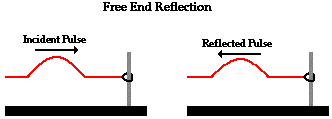
Fixed-End Reflection:
-A wave’s medium being attached to
a fixed end. Meaning, the end of the
medium will not be able to move (reflection
from rigid obstacle)
-In this reflection, the reflected wave is inverted from the incoming wave (with the same speed, wavelength, and amplitude as the
incident pulse)
-Results in phase change:
(crest-> trough)
(trough-> crest)undefined
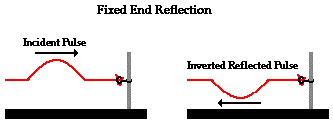
Transmission of a Pulse Across a Boundary from
Less to More Dense
-Consider a thin rope attached to a thick rope, making the point where the two ropes are attached the boundary.
-At this point, an incident pulse will transfer from the less dense medium (thin rope) to the boundary with a more dense medium (thick rope).

-In this situation, part of the wave is reflected
and another part of the wave is transmitted.
-The transmitted pulse is upright, while the
reflected pulse is inverted
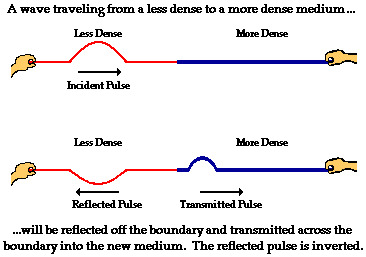
Refraction
-When a wave changes speed as it moves
through a new medium but the frequency
remains the same
-The speed of any mechanical wave as it propagates through a medium is dependent mainly on the type of medium. The denser the medium, the slower the speed

In simpler terms, we can evaluate the concept
of refraction present in bodies of water. When you insert an object straight into the water it may create an illusion making it seem as if the object has bent. This is because water is denser than air, so when light goes from air to water it slows down which causes a shift in the lights direction.
Diffraction
The spreading out of waves, especially when
they pass through an opening which is smaller
than the wavelength. It is the bending of waves
around small openings or past cornersundefined
We can think of diffraction as light entering a
dark room. When the door is closed, the path of light is forbidden to enter the room. Only until the door is opened partially, the light transfers inside with a bend around the door. In this case, the door acts as an obstacle in the path
of light.
Doppler effect
Doppler effect refers to the change in wave
frequency during the relative motion between
a wave source and its observer.
If the source is approaching the detector/observer,
the speed of the source is negative
If the source is receding from the detector/observer,
the speed of the source is positive
When the source moves away from the listener
When a source moves towards a stationary listener (Vobserver=0)
